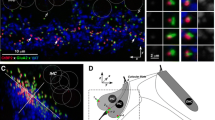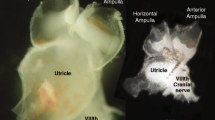Abstract
Reciprocal synapses are characterized by the presence of both afferent and efferent types of synaptic specializations between two cells. They have been described at the neural poles of outer hair cells (OHCs) in humans with advanced age and two monkey species. Our objective was to study the innervation of the OHCs and determine if reciprocal synapses were present in a young (8-month-old infant) human subject. We studied the synaptic and cytoplasmic morphology of 162 nerve terminals innervating 29 OHCs using serial section transmission electron microscopy. Seventy-six percent of all OHCs were innervated by terminals with reciprocal synapses. This prevalence increased from the first toward the third row (p < 0.001), and 100% of OHCs in the third row demonstrated at least one reciprocal synapse. The prevalence of terminals with reciprocal synapses was higher in the human infant than in older human subjects and was very similar to what has been reported for the chimpanzee. Reciprocal synapses occur in sufficient numbers to be physiologically significant in primates. The nerve terminals were found to segregate into two groups on the basis of their cytoplasmic morphological characteristics: (1) vesicle-rich/neurofilament-poor (VR/NP) and (2) vesicle-poor/neurofilament-rich (VP/NR). All afferent and reciprocal terminals were of the VP/NR variety. The majority of the efferent terminals originated from VR/NP nerve fibers (classical olivocochlear morphology), but 23.5% of the efferent terminals were VP/NR. The hypothesis that peripheral processes of type II spiral ganglion cells form classical afferent, reciprocal, and a number of purely presynaptic terminals on OHCs is discussed. The presence of different types of synaptic specializations on OHCs formed by nerve fibers of the same type (VP/NR) suggests the existence of reciprocal neuronal circuits between OHCs sharing the dendritic arborization of a type II spiral ganglion cell.
Similar content being viewed by others
Author information
Authors and Affiliations
Rights and permissions
About this article
Cite this article
Thiers, F., Burgess, B. & Nadol, J. Reciprocal Innervation of Outer Hair Cells in a Human Infant. JARO 3, 269–278 (2002). https://doi.org/10.1007/s101620020024
Received:
Accepted:
Published:
Issue Date:
DOI: https://doi.org/10.1007/s101620020024




